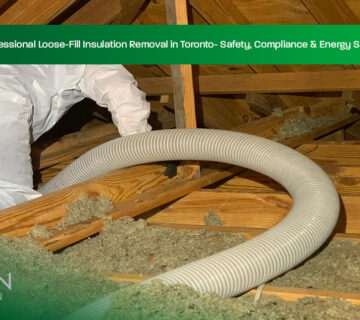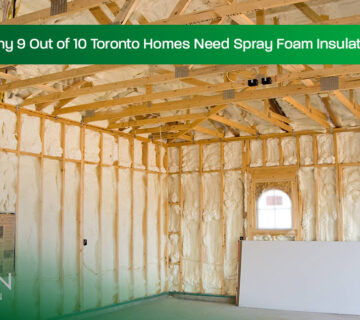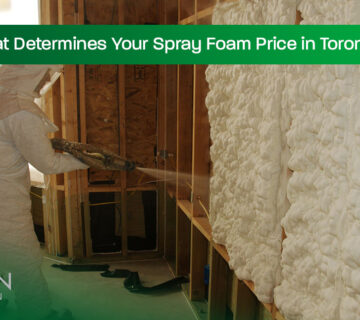Is spray foam insulation right for your Toronto home? It’s a question more homeowners are asking as energy bills rise and extreme weather becomes the norm. While spray foam offers unmatched air sealing, energy savings, and comfort for Toronto’s harsh climate—ranging from freezing January winds to humid August heatwaves—it’s only as effective as the team installing it. Done poorly, even the best materials can underperform. But when you partner with a certified, experienced contractor like Milan Insulation, you gain far more than just insulation: you get peace of mind, code-compliant installation, and a solution tailored to your home’s unique structure and needs.
In fact, choosing a professional for spray foam insulation in Toronto doesn’t just avoid potential pitfalls—it unlocks hidden benefits. Experts like Milan Insulation (a CUFCA-certified contractor serving the GTA) don’t just spray foam; they assess your home’s air leakage points, recommend the right foam type (open-cell vs. closed-cell), ensure proper ventilation, and help you access rebates like the Canada Greener Homes Grant. Their precision turns insulation into a strategic upgrade—boosting comfort, indoor air quality, and long-term value. So while concerns about cost or complexity are understandable, the real story isn’t about drawbacks—it’s about how the right partnership transforms spray foam into one of the smartest investments you can make in your Toronto home.
Table of Contents
ToggleSpray Foam Insulation for Your Toronto Home
When it comes to home performance in Toronto’s unpredictable climate—bitter winters, humid summers, and everything in between—choosing the right insulation isn’t just about comfort. It’s about energy efficiency, indoor air quality, long-term cost savings, and even your home’s resale value. Among the many insulation options available, spray foam insulation consistently ranks as one of the most effective solutions for modern homes.
But you’ve probably heard mixed things. Maybe someone warned you it’s “too expensive,” “hard to repair,” or “not eco-friendly.” So, is spray foam insulation right for your Toronto home? The short answer: Yes—for most homeowners. But like any high-performance building material, it’s not without considerations.
In this in-depth guide, we’ll address the top concerns about spray foam insulation in Toronto honestly, transparently, and with technical accuracy—so you can make an informed decision with confidence.

Is Spray Foam Insulation Right for Your Toronto Home? Let’s Examine the Facts
Toronto homes face unique challenges: aging infrastructure (especially in neighborhoods like The Annex, Riverdale, or Etobicoke), inconsistent original insulation, air leakage through old windows and wall cavities, and rapidly rising energy costs. Traditional insulation like fiberglass batts often underperforms in these conditions because it doesn’t seal air gaps—it only slows heat transfer.
Spray foam insulation, by contrast, does both:
- It insulates (high R-value per inch)
- It air-seals (expands to fill every crack, gap, and void)
This dual action makes it exceptionally well-suited for Toronto’s climate zone (Zone 6 per the National Energy Code of Canada). But before you commit, let’s look at the most common concerns—and what they really mean for your home.
1. “Spray Foam Is Too Expensive”
The Concern: Upfront costs for spray foam are higher than fiberglass or cellulose—sometimes 2–3x more.
The Reality: Yes, the initial investment is greater. But life-cycle cost analysis tells a different story.
In Toronto, where heating accounts for up to 60% of your annual energy bill, spray foam can reduce heating and cooling costs by 30–50%. Over 10–15 years, those savings often offset the initial cost difference—and then some.
Moreover, spray foam:
- Never settles or compresses (unlike fiberglass)
- Requires no maintenance
- Lasts the lifetime of the home (50+ years)
For Toronto homeowners planning to stay put or increase property value, spray foam delivers long-term ROI, not just comfort.
2. “It Traps Moisture and Causes Mold”
The Concern: Because spray foam is airtight, some fear it “locks in” moisture and promotes mold growth.
The Reality: This is a misunderstanding of building science—not a flaw of the product itself.
Closed-cell spray foam (R-6.0–R-7.0 per inch) acts as both an insulator and vapor barrier, preventing warm, moist indoor air from contacting cold sheathing in winter—where condensation and mold typically form.
Open-cell spray foam (R-3.5–R-3.7 per inch) is vapor-permeable, allowing walls to “breathe” while still sealing air leaks. When properly installed with a smart vapor retarder (e.g., in accordance with the Ontario Building Code), mold risk is lower than with traditional insulation.
The real cause of mold in Toronto homes? Air leakage—not airtightness. Uncontrolled airflow carries moisture into wall cavities, where it condenses. Spray foam stops that airflow at the source.

3. “It’s Bad for Indoor Air Quality or Health”
The Concern: Chemicals in spray foam—like isocyanates—must be dangerous, right?
The Reality: During installation, yes—raw chemicals require professional handling. That’s why certified technicians wear PPE and vacate the home for 24 hours post-application.
But once cured (within hours), spray foam becomes inert plastic—chemically stable and non-toxic. It does not off-gas over time.
In fact, by sealing cracks where outdoor pollutants, pollen, dust, and allergens enter, spray foam improves indoor air quality—a major benefit for Toronto families dealing with seasonal allergies or urban air pollution.
Independent studies (including by the U.S. EPA and Health Canada) confirm that fully cured spray foam poses no health risk to occupants.
4. “It Makes Future Repairs or Renovations Harder”
The Concern: If I need to run new wiring or plumbing later, won’t spray foam make it impossible?
The Reality: This is partially true—but manageable.
Once spray foam cures, it’s rigid (closed-cell) or semi-rigid (open-cell). You can’t “push it aside” like fiberglass. But professional electricians and plumbers work through it all the time—using core drills, careful routing, or accessing cavities from unfinished spaces (e.g., basements or attics).
Smart planning minimizes issues:
- Run future-proof conduits during initial insulation
- Leave service cavities in walls where needed
- Use open-cell in areas likely to need access (e.g., interior partition walls)
For most Toronto retrofits—especially in attics, rim joists, or foundation walls—this isn’t a concern at all. These are non-service areas where maximum sealing is ideal.
5. “It’s Not Eco-Friendly”
The Concern: Spray foam uses petroleum-based chemicals and blowing agents with high global warming potential (GWP).
The Reality: The industry has evolved—dramatically.
Modern spray foam formulations (especially from major Canadian manufacturers) now use:
- Low-GWP blowing agents (e.g., HFOs instead of HFCs)
- Bio-based components (up to 20% renewable content)
- Zero ozone-depleting substances
More importantly, the carbon payback period—the time it takes for energy savings to offset the embodied carbon of production—is often under 2 years in Toronto’s climate.
After that? Decades of reduced fossil fuel consumption, fewer emissions from power plants, and less strain on the grid during heat waves.
Compared to the ongoing environmental cost of inefficient homes, spray foam is a net positive for sustainability.
6. “All Installers Are the Same—So I’ll Just Go with the Cheapest”
The Concern: “Why pay more if the product is the same?”
The Reality: Installation quality matters more than the product itself.
Spray foam is not DIY-friendly. It requires:
- Precise temperature and humidity control
- Proper mixing ratios
- Correct pass thickness
- Building science knowledge
Poor installation leads to:
- Shrinkage
- Incomplete curing
- Reduced R-value
- Adhesion failure
In Toronto, always choose a contractor certified by the Canadian Urethane Foam Contractors Association (CUFCA). CUFCA members undergo rigorous training, carry $2M+ liability insurance, and offer manufacturer-backed warranties.

Beyond Concerns: The Undeniable Benefits for Toronto Homes
Now that we’ve addressed the myths, let’s highlight why spray foam remains the gold standard for Toronto homeowners:
Superior R-Value per Inch
- Closed-cell: R-6.5/inch
- Open-cell: R-3.6/inch
- Fiberglass: R-2.2–R-3.8/inch (and degrades over time)
Air Sealing = Comfort + Efficiency
Seals gaps around outlets, windows, ducts, and sill plates—common in older Toronto homes.
Reduces Ice Damming
By preventing warm air from escaping into the attic, spray foam keeps roof sheathing cold—stopping snow melt/refreeze cycles that cause ice dams (a major issue in North Toronto winters).
Improves Structural Strength
Closed-cell foam adds racking strength to walls—great for wind resistance and older brick homes.
Noise Reduction
Open-cell foam absorbs sound, making your home quieter from street traffic (ideal for downtown condos or busy intersections like Danforth or Finch).
conclusion
while spray foam insulation may come with upfront costs and require professional installation, its long-term benefits far outweigh the concerns—especially for homeowners in Toronto’s demanding climate. When applied correctly by certified experts, spray foam delivers superior energy efficiency, enhanced comfort, improved indoor air quality, and lasting durability. So, is spray foam insulation right for your Toronto home? For most homeowners seeking a smarter, more resilient, and future-proof living space, the answer is a confident yes.
FAQs
Is spray foam insulation safe for families and pets once installed?
Can spray foam be installed in older Toronto homes?
Absolutely. In fact, older homes (common in neighborhoods like Cabbagetown, High Park, or Leaside) often benefit the most due to significant air leakage. Spray foam can be retrofitted into attics, basements, rim joists, and wall cavities with minimal disruption.
What’s the difference between open-cell and closed-cell spray foam for Toronto climates?
Open-cell foam (R-3.6/inch) is vapor-permeable and ideal for interior walls and sound dampening. Closed-cell foam (R-6.5+/inch) provides higher insulation value, acts as a vapor barrier, and adds structural strength—making it excellent for attics, basements, and exterior walls in Toronto’s cold, humid climate.





No comment